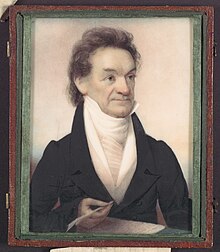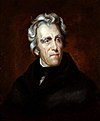Edward Livingston
Edward Livingston | |
|---|---|
Edward Douglass White Sr. | |
| 46th Mayor of New York City | |
| In office 1801–1803 | |
| Preceded by | Richard Varick |
| Succeeded by | DeWitt Clinton |
| Member of the U.S. House of Representatives from New York's 2nd district | |
| In office March 4, 1795 – March 3, 1801 | |
| Preceded by | John Watts |
| Succeeded by | Samuel L. Mitchill |
| Personal details | |
| Born | May 28, 1764 Rhinebeck, New York, U.S. |
| Political party | Democratic-Republican (before 1825) Jacksonian (1825–1836) |
| Spouses | Mary McEvers
(m. 1788; died 1801)Louise d'Avezac de Castera
(m. 1805) |
| Relations | See Livingston family |
| Education | Princeton University (BA) |
| Signature | |
Edward Livingston (May 28, 1764 – May 23, 1836) was an American jurist and statesman. He was an influential figure in the drafting of the
Early life
Edward Livingston was born in
His maternal grandparents were
He graduated from Princeton University in 1781.[10]
Career
Livingston was admitted to the bar in 1785, and began to practice law in New York City along with
Livingston was a prominent opponent of the
In 1801, Livingston was appointed United States Attorney for the district of New York, and while retaining that position was in the same year appointed Mayor of New York City. When, in the summer of 1803, the city was visited with yellow fever, Livingston displayed courage and energy in his endeavors to prevent the spread of the disease and relieve distress. He suffered a violent attack of fever, during which the people gave many proofs of their attachment to him.[13]
Upon his recovery he found his private affairs in some confusion, and he was at the same time deeply indebted to the government for public funds which had been lost through the mismanagement or dishonesty of a confidential clerk, and for which he was responsible as US attorney. He at once surrendered all his property, resigned his two offices in 1803, and moved early in 1804 to New Orleans in what would shortly become the Territory of Orleans (1804–1812).[14] His older brother, Robert R. Livingston, had negotiated the Louisiana Purchase, in 1803.[citation needed] Edward Livingston soon built a large law practice in New Orleans, and in 1826 he repaid the Federal government in full, including the interest, which by that time amounted to more than the original principal.[14]
Louisiana
Almost immediately upon his arrival in Louisiana, where the legal system had previously been based on
In 1807, after conducting a successful suit on behalf of a client's title to a part of the batture or alluvial land near New Orleans, Livingston attempted to improve part of this land (which he had received as his fee) in the Batture Ste. Marie. Great popular excitement was aroused against him; his workmen were mobbed; and territorial Governor William C. C. Claiborne, when appealed to for protection, referred the question to the Federal government.[14]
It has been alleged that Livingston's case was damaged by then-President
Livingston Code
In 1821, by appointment of the
The Livingston Code was at once reprinted in England, France, and Germany, attracting wide praise by its remarkable simplicity and vigor, and especially by reason of its philanthropic provisions in the code of reform and prison discipline, which noticeably influenced the penal legislation of various countries. In referring to this code, Sir Henry Maine spoke of Livingston as "the first legal genius of modern times."[16] The spirit of Livingston's code was remedial rather than vindictive; it provided for the abolition of capital punishment and the making of penitentiary labor not a punishment forced on the prisoner, but a matter of his choice and a reward for good behavior, bringing with it better accommodations. His Code of Reform and Prison Discipline was adopted by the government of the short-lived Federal Republic of Central America under liberal president Francisco Morazán.[14]
Livingston was the leading member of a commission appointed to prepare a new
Later career

Livingston served as a U.S. Representative from Louisiana from 1823 to 1829, a U.S. Senator from 1829 to 1831, and for two years (1831–1833) United States Secretary of State under President Jackson. In this last position he was one of Jackson's most trusted advisers. Livingston prepared a number of state papers for President Jackson, the most important being the famous anti-nullification proclamation of December 10, 1832.[14]
From 1833 to 1835, Livingston was minister plenipotentiary to France, charged with procuring the fulfillment by the French government of the treaty negotiated by W. C. Rives in 1831, by which France had bound herself to pay an indemnity of twenty-five millions of francs for French spoliations of American shipping chiefly under the Berlin and Milan decrees, and the United States in turn agreed to pay to France 1,500,000 francs in satisfaction of French claims. Livingston's negotiations were conducted with excellent judgment,[citation needed] but the French Chamber of Deputies refused to make an appropriation to pay the first installment due under the treaty in 1833, relations between the two governments became strained, and Livingston was finally instructed to close the legation and return to America.[14]
Personal life
Livingston was married twice. His first wife, Mary McEvers, whom he wed on April 10, 1788, later died of scarlet fever.[10] She was the daughter of Charles McEvers and Mary (née Bache) McEvers and her sister, Eliza McEvers, was the second wife of Edwards older brother, the merchant John R. Livingston.[10] Before her death on March 13, 1801, they were the parents of three children:[11]
- Charles Edward Livingston (born 1790)
- Julia Livingston (1794–1814)
- Lewis Livingston (1798–1822)
In June 1805, he married Madame Marie Louise Magdaleine Valentine "Louise" (née d'Avezac) de Castera Moreau de Lassy (1785–1860), a widow who was then only 19 years of age, and a refugee in New Orleans from the
- Coralie Livingston (1806–1873), who married Thomas Pennant Barton (1803–1869), the son of noted physician Benjamin Smith Barton, in April 1833.[10]
Livingston died on May 23, 1836, five days before his 72nd birthday at Montgomery Place in Red Hook, New York, an estate left him by his sister, to which he had removed in 1831.[10]
Legacy and honors
The town of Livingston, Guatemala, is named after Edward Livingston, in commemoration of the Livingston Code.
Edward Livingston is the namesake of counties in Illinois, Michigan, and Missouri,[19] and a parish in Louisiana with its seat of Livingston. Also named for him is a town in Tennessee, a town in Livingston, Alabama, a Sumter County, Alabama, and by extension, the town of Livingston, Texas, Lake Livingston in Texas, and the Livingston Dam.
Edward Livingston High School[20] (formerly a middle school) in New Orleans was named for him. Fort Livingston, a 19th-century coastal fortification, was named after Edward Livingston, along with today's Fort Livingston State Commemorative Area in south Louisiana.
Livingston was elected a member of the American Philosophical Society[21] in 1825 and the American Antiquarian Society[22] in 1833.
References
- ^ Lawrence Friedman, A History of American Law (New York: Simon & Schuster, 2005), p. 118. Louisiana, along with Scotland and Quebec, is one of a few "mixed" jurisdictions whose law derives from both the civil and the common law traditions.
- ^ U.S. Department of State, "Secretary of State Edward Livingston" (July 15, 2003), http://history.state.gov/departmenthistory/people/livingston-edward.
- ^ "Livingston, Robert (1746-1813) to John R. Livingston". www.gilderlehrman.org. Gilder Lehrman Institute of American History. Retrieved January 17, 2018.
- ISBN 9780814780398. Retrieved January 17, 2018.
- ^ a b c "Friends of Clermont Historic Site". friendsofclermont.org. Friends of Clermont Historic Site. Retrieved January 17, 2018.
- ISBN 978-1400823598. Retrieved January 17, 2018.
- ^ Clermont State Historic Site (May 16, 2016). "Clermont State Historic Site: Was John R. Livingston a Murderer?". Clermont State Historic Site. Retrieved January 17, 2018.
- ^ "John R. Livingston (1755-1851)". www.nyhistory.org. New-York Historical Society. Retrieved January 17, 2018.
- ISBN 9781351532150. Retrieved January 17, 2018.
- ^ a b c d e f g h Livingston, Edwin Brockholst (1910). The Livingstons of Livingston Manor: Being the History of that Branch of the Scottish House of Callendar which Settled in the English Province of New York During the Reign of Charles the Second; and Also Including an Account of Robert Livingston of Albany, "The Nephew," a Settler in the Same Province and His Principal Descendants. Knickerbocker Press. Retrieved August 10, 2017.
- ^ a b Aitken, William Benford (1912). Distinguished Families in America, Descended from Wilhelmus Beekman and Jan Thomasse Van Dyke. Knickerbocker Press. pp. 51–52. Retrieved January 16, 2019.
- ^ a b Chisholm 1911, p. 811.
- ^ Chisholm 1911, pp. 811–812.
- ^ a b c d e f g h i j k l Chisholm 1911, p. 812.
- ^ See Dumas Malone's biography, Jefferson and His Time - Volume 6, The Sage of Monticello, ch. 5, "The Batture Controversy".
- ^ Cambridge Essays, 1856, p. 17.
- ^ Browning, Charles Henry (1891). Americans of Royal Descent: A Collection of Genealogies of American Families Whose Lineage is Traced to the Legitimate Issue of Kings. Porter & Costes. p. 167. Retrieved January 16, 2019.
- ^ July 1805 Matrimony notice of Moreau de Lassy.
- ^ Eaton, David Wolfe (1916). How Missouri Counties, Towns and Streams Were Named. The State Historical Society of Missouri. pp. 188.
- ^ New Orleans Public Schools Superintendent's report of February 2013 page 13, accessed April 6, 2015.
- ^ "APS Member History". search.amphilsoc.org. Retrieved April 6, 2021.
- ^ American Antiquarian Society Members Directory
- This article incorporates text from a publication now in the public domain: Chisholm, Hugh, ed. (1911). "Livingston, Edward". Encyclopædia Britannica. Vol. 16 (11th ed.). Cambridge University Press. pp. 811–812.
Further reading
Hatcher, William B., Edward Livingston: Jeffersonian Republican and Jacksonian Democrat, Louisiana State University Press (1940).
Hunt, Charles Havens, Life of Edward Livingston, Appleton & Co. (1863).
External links
- United States Congress. "Edward Livingston (id: L000366)". Biographical Directory of the United States Congress.
- Office of the Historian profile at U.S. Department of State
- Edward Livingston Letters at The Historic New Orleans Collection







